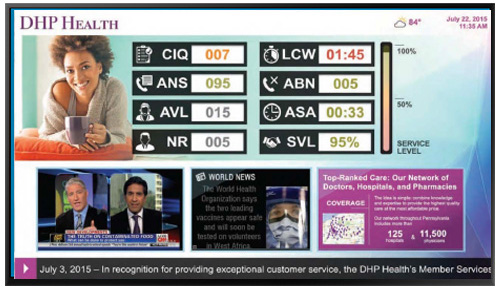Get Your Digital Signage Degree in “Be Prepared!”
Higher education is supposed to be about the first steps in learning the life and career students are excited to discover and faculty are proud to teach. But today’s harsh world has a different lesson plan in mind. Your guest lecturers? Natural disaster. Health emergencies. Terrorism. Active shooters.
As unwelcome as these cruel teachers may be, they nonetheless seem here to stay. Rather than simply accept their tenure, your college or university has the opportunity to counter this chaos with a lesson in the cool, rational communication of campus digital signage.
With thousands of students and faculty spread across a college campus, screens located in key locations can be set to change color and animate, to draw attention as the first place to look for special alerts and emergency announcements. In the event of tornadoes, wildfires or dangerous individuals, updates that access real-time news feed can provide warnings, with instructions on where to evacuate — or shelter in place.
In times of less immediate danger, digital signage can be a consistent educator that reminds students of sensible precautions related to their personal safety, increases in local crime, and health protocols and procedures.
The Immediate Advantages of Digital Signage
The same communication principles that make digital signage so powerful for everyday communication makes it even more impactful in emergency situations.
- Digital signage captures attention: A static image is easy to overlook, but a dynamic display is going to draw the eye.
- Digital signage drives action: Animated visuals elicit emotional response that prompts people to act on the information — critical in a crisis setting.
- Digital signage delivers alerts and notifications when and where they’re needed. Key information can be pre-set in advance, targeted to display on different screens based on location and relevancy, and updated remotely at a moment’s notice.
Campus Wide Control
In an emergency situation, you want your digital signage centrally managed through a single, strong communications platform that’s internet-enabled through the cloud. This makes it fast and easy to publish the tactical updates that are so essential in the time-critical moments that punctuate a crisis.
An intelligent content management system will also be able to send your crisis alerts to mobile devices and remote campus screens, as well as integrate with any audio and text message components — ensuring situational messaging across campus is both extensive and consistent.
Crisis Communication On Location
Your communications and IT teams have already installed eye-catching digital signage across campus for everyday notices about school functions and classroom scheduling. But your opportunity for crisis communication doesn’t end at your standalone monitors and displays. Your workplace communications software can — and should — tie into the numerous other screens that constitute your digital signage network: conference room collaboration screens, digital menus in cafeterias, library kiosks and more.
Depending on your system, you’ll be able to utilize this network to interrupt normal services with alert notices that can ensure safety — perhaps even preserve life. In a campus wide emergency, digital signage steps up thanks to its versatility. When a crisis begins, every display can coordinate as a mass notification network, from your stadium screens to the small displays outside lecture halls.
Dangerous storm on the horizon? A single-color background illuminates every screen, creating a stark contrast to the surroundings and drawing all attention where it needs to be.
A flashing graphic of a storm illustrates the emergency and urgency, while streaming text from local weather and emergency services describes highlights of the danger. A screen refresh brings up a large map for wayfinding to direct the campus population to the nearest safe spots.
With digital signage, emergency alerts are no longer limited to one single message for an entire campus. As the situation evolves (or devolves!) digital signage keeps up based on geo-specific location and targeted audience relevancy. Strategic planning can utilize your workplace communications platform and content management system to deliver unique safety information aligned with specific facilities and areas.
At the health center, screens shift to provide specific direction for any students or faculty who have been injured and are waiting on care. As the emergency level decreases, digital signage in the residence halls and student union shift to directing victims who to contact and where the campus community can donate items for those in need.
It’s no exaggeration to say that a proactive digital signage system that keeps students and faculty informed in times of crisis can reduce confusion, avert tragedy, and even save lives.
Plan Well for the Worst Moments
Do you need to wait until the dominoes start to fall to fire up your emergency digital signage? Not with the crisis templates built into an intelligent content management system. Professional designs are available to arrest attention and direct action whether it’s harsh weather, fire, violence, hazmat, or health concern. Any dire situation can be customized in advance and ready to activate at the moment of trouble.
A good strategy for emergency digital signage is to create alerts that look similar and appear in the same place on every display. Consistency will help your campus community know where to look when events take a turn for the worse.
In general, it’s smart practice to enliven your university campus digital signage with refreshed and interesting content even during times of non-emergency. Your workplace communication platform will drive this content for you, as it helps your campus population develop the habit of looking to your screens. Then, when trouble hits your institute of higher learning, these vibrant, compelling and helpful displays will be a natural place to turn to for information and guidance.
Learn From Troubled Times
Digital signage can do more than communicate emergency protocols in the moment of crisis. The analytics gathered during the worst of times can be instructional moments for disaster planners and their future communication strategies
Coordinating proof of play with campus community behavior can help course correct next level messaging. Did your COVID alerts lead to more or less social distancing among students and faculty? If it’s less than expected, it may be time to adjust the content on your digital signage before the next wave of variants.
More advanced analytic opportunities can use discrete cameras to track non-identifying data like foot traffic, impressions and engagement time: useful information in gauging which displays provide the most service at the height of an emergency. Cross referencing these numbers with class schedules and campus events can allow for smarter data-driven decisions when responding to the next crisis situation — such as planning the most effective evacuation route.
Digital Signage = Safety First
Everyone only wants the best of their college experience. But the world remains all too unpredictable, and the potential for tragedy at and around schools is all too real.
Every emergency will affect and disrupt every individual at your school differently.
Digital signage can be their common ground: the “keep calm and carry on” that quells the chaos. The automated features of a workplace communications platform mean your staff aren’t struggling to get out crisis notifications. Instead, your digital signage provides the ability to focus precious time and resources on protecting your people.
Few times are better at demonstrating the power of effective communications than a crisis. Digital signage can not stop the worst from happing. But a robust workplace communications platform such as Korbyt Anywhere can be a critical part of keeping students and faculty aware and safe.









